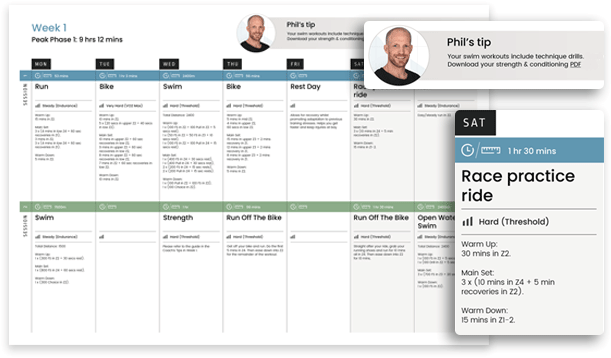Free Half Marathon Training Plans & Tips
- Detailed 8- and 12-week training plans
- Beginner, Intermediate & Advanced versions
*Plus, you’ll also receive free regular training tips from head coach Phil Mosley! Unsubscribe at any time.
How To Train For A Half Marathon
- Scroll down for our 12-week training plan in full!
The best way to train for a half marathon is to build up your training slowly over a period of weeks and months. Most people start off by running too far, too fast, or too regularly, and then get injured or lose motivation. A good way to avoid this is by following an expertly designed training plan. People who use training plans have been shown to be twice as likely to succeed in reaching their goals.
Running Tips
If you’re a total beginner, your runs should start at 15 minutes in duration and increase gradually over a period of weeks or months. If this feels too hard for you, walk briskly instead, until you’re fit enough to include a little running in your workouts. Over time you will be able to run more and walk less. Aim to increase the duration of your workouts by no more than 10% per week. Your runs should not feel too intense at this stage – ideally, you should be able to talk while you’re running, as a way of knowing that you’re not going too hard. If not, slow down or include some walking sections. If you ignore this, you increase your risk of getting injured.
Once you have built up to running 30 minutes comfortably, you can then structure your training program around three key runs per week. The first key session is an endurance session, where you build up over the weeks and months to around 1 hour 30 minutes of low intensity running.
The second key session is a speed session, with a warm up, a warm down and some hard efforts sandwiched in between – such as 4 x 3 minutes hard with 2-minute recoveries.
The third key session should be a run that includes some half-marathon paced efforts, so you get used to the demands of race day. For example, 2 x 10 minutes at half marathon pace, with 3-minute recoveries (plus, warm up and warm down). We include these kinds of workouts in our half marathon training plans. All your key sessions should continuously evolve and progress over time, so your body is forced to adapt and improve.
If you do additional runs, they can be steady jogs of around 30-60 minutes. If possible, do some of your running on soft surfaces like grass or trails, to reduce the impact on your body. Training on hillier terrain is good too, because it spreads the load to a broader range of muscle fibers, compared to running on flat ground. Always be mindful of avoiding injury – over half of all runners are injured every year. In our beginner, intermediate and advanced half marathon training plans we make every fourth week an “active recovery week” where the training is halved. This gives your body a chance to recover and get stronger.
Strength Training Tips
In our half marathon training plans, there are usually two 40-minute strength and conditioning sessions each week. These workouts can help improve your strength and flexibility, leading to more efficient movement patterns and fewer injuries. We suggest you only do strength work in addition to at least three runs per week, rather than instead of them.
Using A Half Marathon Training Plan
Our training plans are for athletes who don’t feel the need for a personal coach, but who still want the structure and planning of an expertly-written training program. Research has shown that you are twice as likely to reach your goals if you train with a structured plan.
For a beginner who has some recent background in fitness or sport, we suggest you give yourself at least 12-16 weeks to get fit and ready for a Half Marathon race. The sooner you start, the more time you have to build up your fitness gradually. Fitness adaptations take weeks and months to occur, rather than days.
The free 8 and 12-week training plans on this page give you an idea of what to expect, but you may also benefit from a longer plan that starts easier and ramps-up more gradually. Click here to browse our 6 to 40-week training plans (with email support).
Do your best to follow the workouts below, ideally in their given order. To help you train at the right levels, we use five training zones, based on feel or heart rate. If you use heart rate, you can use our simple heart rate training zone calculator. Note: our premium plans include fitness tests for smarter, personalised training zones on every workout.
- Zone 1 – Feels like “Easy/Recovery” – Heart rate 68-73% of max.
- Zone 2 – Feels like “Steady/Endurance” – Heart rate 73-80% of max.
- Zone 3 – Feels like “Mod. Hard/Tempo” – Heart rate 80-87% of max.
- Zone 4 – Feels like “Hard/Threshold” – Heart rate 87-93% of max.
- Zone 5 – Feels like “V. Hard/VO2 Max” – Heart rate 93-100% of max.
We abbreviate your zones to keep things easy to read:
- Z1 to Z5 – Your training zone.
- Detailed 8- and 12-week training plans
- Beginner, Intermediate & Advanced versions
- Strength & Conditioning guide, coach's tips and more!
*Plus, you’ll also receive free regular training tips from head coach Phil Mosley! Unsubscribe at any time.
12-Week Beginner Half Marathon Plan
This training plan is suitable for Beginner or time-limited runners, aiming for a first Half Marathon. With just 12 weeks to go until event-day, this plan assumes you are currently able to run/jog for up to 40 mins. Your training will build up to race day and help you improve fitness and confidence. A good way to avoid injury and stay motivated is by following an expertly designed training plan. People who follow a training plan have been shown to be twice as likely to succeed in reaching their goal.
Average weekly training hours are 3:44 with the biggest week at 4:37 hours. This includes four runs and a 45-minute strength and conditioning session. There is usually one workout per day, with two days off each week. Every fourth week is an active recovery week, with less training, to help your body recover and adapt.
- To get the 8-week version of this plan and access to the Strength & Conditioning guide, please enter your email above.
Week 1 - Base Phase (3 hrs 11 mins)
Monday: Tempo Run – Hard/Threshold (34 mins)
- Warm Up:
- 15 mins in Z2 to Z3.
- Main Set:
- 2 x (6 mins in low Z4 + 2 min recovery in Z1).
- Warm Down:
- 5 mins in Z2.
Tuesday: Recovery Day
- Allows for recovery whilst promoting adaptation to previous training stresses. Helps you get faster and keep injuries at bay.
Wednesday: Aerobic Endurance – Steady/Endurance (35 mins)
- All in low to mid Z2. These runs are to be done slowly. They will gradually build your endurance and increase your efficiency. If you do them faster, you’ll increase your injury risk for no real benefit. If you need to include some walking sections in these runs, in order to keep your heart rate down, that’s fine.
Thursday: Strength – Adaptation Phase (45 mins)
Friday: Strength Endurance – V. Hard/VO2 Max (37 mins 30 secs)
- Warm Up:
- 15 mins in Z2 to Z3.
- Main Set:
- 5 x (90 secs in low Z5 up a hill (gradient should be 3 to 6%) + 2 min recoveries in Z1-Z2).
- Warm Down:
- 5 mins in Z2.
Saturday: Recovery Day
Sunday: Aerobic Endurance – Steady/Endurance (40 mins)
- All in low to mid Z2. This is your long run and will gradually increase in duration. If you need to include some walking sections in these runs, in order to keep your heart rate down, that’s fine.
- Click the headings below to view the remaining weeks!
Week 2 - Base Phase (3 hrs 35 mins)
Monday: Recovery Day
Tuesday: Tempo Run – Hard/Threshold (40 mins)
- Warm Up:
- 15 mins in Z2.
- Main Set:
- 20 mins in low Z4.
- Warm Down:
- 5 mins in Z2.
Wednesday: Aerobic Endurance – Steady/Endurance (40 mins)
- All in low to mid Z2
Thursday: Strength – Adaptation Phase (45 mins)
Friday: Strength Endurance – V. Hard/VO2 Max (40 mins)
- Warm Up:
- 10 mins in Z2.
- 4 x (30 secs accelerating from Z2 to Z4 + 30 sec recoveries in Z1).
- Main Set:
- 6 x (90 secs in low Z5 up a hill (gradient should be 3 to 6%) + 2 min recoveries in Z1-Z2).
- Warm Down:
- 5 mins in Z2.
Saturday: Recovery Day
Sunday: Aerobic Endurance – Steady/Endurance (50 mins)
- Easy or steady run all in low to mid Z2.
Week 3 - Base Phase (4 hrs 03 mins)
Monday: Recovery Day
Tuesday: Tempo Run – Hard/Threshold (44 mins)
- Warm Up:
- 15 mins in Z2.
- Main Set:
- 7 mins in low Z4 + 2 mins recovery in Z1,
- 6 mins in low Z4 + 2 mins recovery in Z1,
- 5 mins in low Z4 + 2 mins recovery in Z1.
- Warm Down:
- 5 mins in Z2.
Wednesday: Aerobic Endurance – Steady/Endurance (45 mins)
- All in low to mid Z2.
Thursday: Strength – Endurance Phase (45 mins)
Friday: Strength Endurance – V. Hard/VO2 Max (48 mins 30 secs)
- Warm Up:
- 10 mins in Z2.
- 4 x (30 secs accelerating from Z2 to Z4 + 30 sec recoveries in Z1).
- Main Set:
- 7 x (90 secs in low Z5 up a hill (gradient should be 3 to 6%) + 2 min recoveries in Z1-Z2).
- Warm Down:
- 10 mins in Z2.
Saturday: Recovery Day
Sunday: Aerobic Endurance – Steady/Endurance (1 hr)
- Easy or steady run all in low to mid Z2.
Week 4 - Activity Recovery Week (3 hrs 06 mins)
Monday: Recovery Day
Tuesday: Strength – Endurance Phase (45 mins)
Wednesday: Tempo Run – Hard/Threshold (40 mins)
- Warm Up:
- 15 mins in Z2 to Z3.
- Main Set:
- 2 x (9 mins in low Z4 + 2 min recovery in Z1).
- Warm Down:
- 5 mins in Z2.
Thursday: Aerobic Endurance – Steady/Endurance (30 mins)
- All in low to mid Z2.
Friday: Speed Run – V. Hard/VO2 Max (31 mins)
- Warm Up:
- 8 mins in Z2.
- 4 x (30 secs accelerating from Z2 to Z4 + 30 sec recoveries in Z1).
- Main Set:
- 3 x (2 mins in Z5 + 60 secs in Z1).
- Warm Down:
- 10 mins in Z2.
Saturday: Recovery Day
Sunday: Aerobic Endurance – Steady/Endurance (40 mins)
- Easy or steady run all in low to mid Z2.
Week 5 - Build Phase (4 hrs 17 mins)
Monday: Recovery Day
Tuesday: Progression Run – Hard/Threshold (45 mins)
- Main Set:
- 5 mins in low Z2,
- 5 mins in mid Z2,
- 5 mins in upper Z2,
- 5 mins in low Z3,
- 5 mins in mid Z3,
- 5 mins in upper Z3,
- 5 mins in low Z4,
- 5 mins in mid Z4.
- Warm Down:
- 5 mins in low Z2.
Wednesday: Aerobic Endurance – Steady/Endurance (45 mins)
- All in low to mid Z2.
Thursday: Strength – Endurance Phase (45 mins)
Friday: Race Pace Efforts – Mod. Hard/Tempo (52 mins)
- Warm Up:
- 10 mins in Z2.
- 4 x (30 secs accelerating from Z2 to Z4 + 30 sec recoveries in Z1).
- Main Set:
- 10 mins in high Z2 to low Z3 + 2 min recoveries in Z1,
- 9 mins in high Z2 to low Z3 + 2 min recoveries in Z1,
- 8 mins in high Z2 to low Z3 + 2 min recoveries in Z1.
- Warm Down:
- 5 mins in low Z2.
Saturday: Recovery Day
Sunday: Aerobic Endurance – Steady/Mod. Hard (1 hr 10 mins)
- With Race Pace Finish:
- Easy or steady run all in low to mid Z2.
- Do the last 10 minutes at high Z2 to low Z3.
- This run will help you stay strong when the race feels the toughest. Increasing effort at the end of your long run in training, will give you the confidence to push for the finish on race day.
Week 6 - Build Phase (4 hrs 36 mins)
Monday: Recovery Day
Tuesday: Progression Run – Hard/Threshold (50 mins)
- Main Set:
- 10 mins in low Z2,
- 5 mins in upper Z2,
- 10 mins in low Z3,
- 10 mins in upper Z3,
- 5 mins in low Z4,
- 5 mins in mid Z4.
- Warm Down:
- 5 mins in low Z2.
Wednesday: Aerobic Endurance – Steady/Endurance (45 mins)
- All in low to mid Z2.
Thursday: Strength – Endurance Phase (45 mins)
Friday: Race Pace Efforts – Mod. Hard/Tempo (56 mins)
- Warm Up:
- 5 mins in Z2.
- 4 x (30 secs accelerating from Z2 to Z4 + 30 sec recoveries in Z1).
- Main Set:
- 4 x (9 mins all in high Z2 to low Z3 + 90 sec recoveries in Z1).
- Warm Down:
- 5 mins in low Z2.
Saturday: Recovery Day
Sunday: Aerobic Endurance – Steady/Mod. Hard (1 hr 20 mins)
- With Race Pace Finish:
- Easy or steady run all in low to mid Z2.
- Do the last 10 minutes at high Z2 to low Z3.
Week 7 - Build Phase (4 hrs 37 mins)
Monday: Recovery Day
Tuesday: Progression Run – Hard/Threshold (55 mins)
- Main Set:
- 10 mins in low Z2,
- 5 mins in upper Z2,
- 10 mins in low Z3,
- 10 mins in mid Z3,
- 10 mins in upper Z3,
- 5 mins in low Z4.
- Warm Down:
- 5 mins in low Z2.
Wednesday: Aerobic Endurance – Steady/Endurance (40 mins)
- All in low to mid Z2.
Thursday: Strength – Endurance Phase (45 mins)
Friday: Race Pace Efforts – Mod. Hard/Tempo (47 mins)
- Warm Up:
- 5 mins in Z2.
- 4 x (30 secs accelerating from Z2 to Z4 + 30 sec recoveries in Z1).
- Main Set:
- 3 x (10 mins all in high Z2 to low Z3 + 60 sec recoveries in Z1).
- Warm Down:
- 5 mins in low Z2.
Saturday: Recovery Day
Sunday: Aerobic Endurance – Steady/Mod. Hard (1 hr 30 mins)
- With Race Pace Finish:
- Easy or steady run all in low to mid Z2.
- Do the last 10 minutes at high Z2 to low Z3.
Week 8 - Active Recovery Week (3 hrs 08 mins)
Monday: Recovery Day
Tuesday: Aerobic Endurance – Steady/Endurance (30 mins)
- All in low to mid Z2.
Wednesday: Tempo Run – Hard/Threshold (42 mins)
- Warm Up:
- 15 mins in Z2.
- Main Set:
- 2 x 10 mins in low Z4 + 2 min recovery in Z1.
- Warm Down:
- 5 mins in Z2.
Thursday: Strength – Strength Phase (45 mins)
Friday: Speed Run – V. Hard/VO2 Max (31 mins)
- Warm Up:
- 10 mins in Z2.
- 4 x (30 secs accelerating from Z2 to Z4 + 30 sec recoveries in Z1).
- Main Set:
- 4 x (2 mins in Z5 + 60 secs in Z1).
- Warm Down:
- 5 mins in Z2.
Saturday: Recovery Day
Sunday: Aerobic Endurance – Steady/Endurance (40 mins)
- Easy or steady run all in low to mid Z2.
Week 9 - Peak Phase (4 hrs 32 mins)
Monday: Recovery Day
Tuesday: Aerobic Speed – V. Hard/VO2 Max (47 mins)
- Warm Up:
- 10 mins in Z2,
- 5 x (30 secs accelerating from Z2 to Z5 + 30 secs recoveries in Z1).
- Main Set:
- 1 x (9 x 40 secs in Z5, with 20 sec recoveries in Z1),
- 4 mins recovery in Z1,
- 1 x (9 x 40 secs in Z5, with 20 sec recoveries in Z1).
- Warm Down:
- 10 mins in low Z2.
Wednesday: Aerobic Endurance Strength – Steady/Endurance (40 mins)
- All in low to mid Z2. Ideally on a hilly route.
Thursday: Strength – Strength Phase (45 mins)
Friday: Aerobic Endurance Strength – Steady/Endurance (40 mins)
- All in low to mid Z2. Ideally on a hilly route.
Saturday: Recovery Day
Sunday: Aerobic Endurance – Steady/Mod. Hard (1 hr 40 mins)
- With Race Pace Finish:
- Easy or steady run all in low to mid Z2.
- Do the last 10 minutes at high Z2 to low Z3.
Week 10 - Peak Phase (3 hrs 55 mins)
Monday: Recovery Day
Tuesday: Aerobic Endurance – Steady/Endurance (25 mins)
- All in low to mid Z2.
Wednesday: Aerobic Endurance Strength – Steady/Endurance (40 mins)
- All in low to mid Z2. Ideally on a hilly route.
Thursday: Strength – Strength Phase (45 mins)
Friday: Speed Run V. Hard/VO2 Max (35 mins)
- Warm Up:
- 7 mins in Z2.
- 5 x (30 secs accelerating from Z2 to Z5 + 30 sec recoveries in Z1).
- Main Set:
- 4 x (90 secs in upper Z5 with 3 min recoveries in Z1 to Z2).
- Warm Down:
- 5 mins in low Z2.
Saturday: Recovery Day
Sunday: Aerobic Endurance – Steady/Mod. Hard (1 hr 30 mins)
- With Race Pace Finish:
- Easy or steady run all in low to mid Z2,
- Do the last 15 minutes at high Z2 to low Z3.
Week 11 - Peak Phase (3 hrs 47 mins)
Monday: Recovery Day
Tuesday: Aerobic Endurance Strength – Steady/Endurance (30 mins)
- All in low to mid Z2. Ideally on a hilly route.
Wednesday: Aerobic Endurance Strength – Steady/Endurance (40 mins)
- All in low to mid Z2. Ideally on a hilly route.
Thursday: Strength – Strength Phase (45 mins)
Friday: Speed Run – V. Hard/VO2 Max (37 mins)
- Warm Up:
- 8 mins in Z2.
- 4 x (30 secs accelerating from Z2 to Z5 + 30 sec recoveries in Z1).
- Main Set:
- 3 x (2 mins in upper Z5 + 3 min recoveries in Z1 to Z2).
- Warm Down:
- 10 mins in low Z2.
Saturday: Recovery Day
Sunday: Aerobic Endurance – Steady/Mod. Hard (1 hr 15 mins) With Race Pace Finish
- Easy or steady run all in low to mid Z2,
- Do the last 15 minutes at high Z2 to low Z3.
Week 12 - Race Taper Week (1 hrs 30 mins)
Monday: Recovery Day
- This week you will maintain your fitness and eliminate any traces of fatigue. It’s a good time to double-check your race day logistics and strategies. If your race is on Saturday, move your Friday run to Thursday and take Friday as a rest day
Tuesday: Taper Week Run – Steady/ Endurance (30 mins)
- All in low to mid Z2.
Wednesday: Taper Week Run – Hard/Threshold (30 mins)
- Warm Up:
- 15 mins in Z2.
- Main Set:
- 3 x (60 secs in low Z4 + 2 mins in Z2).
- Warm Down.
- 6 mins in Z2.
Thursday: Recovery Day
Friday: Taper Week Run – Steady/ Endurance (30 mins)
- All in low to mid Z2. If your race is on Saturday, move today’s run to Thursday and take today as a rest day
Saturday: Recovery Day
Sunday: Race Day
- To get this in a printable PDF, plus the 8-week version and the Strength & Conditioning guide, please enter your email below.
- Detailed 8- and 12-week training plans
- Beginner, Intermediate & Advanced versions
- Strength & Conditioning guide, coach's tips and more!
*Plus, you’ll also receive free regular training tips from head coach Phil Mosley! Unsubscribe at any time.
12-Week Intermediate Half Marathon Plan
This short training plan is suitable for Intermediate runners, who want to maximize their Half Marathon potential. With just 12 weeks to go until event-day, this plan assumes you are currently able to run/jog for up to 70 mins. Your training builds up to race day and helps improve your fitness and confidence. A good way to avoid injury and stay motivated is by following an expertly designed training plan. People who follow a training plan have been shown to be twice as likely to succeed in reaching their goal.
Average weekly training hours are 4:52 with the biggest week at 5:59 hours. This includes five runs and a 45-minute strength and conditioning session. There is usually one workout per day, with one day off each week. Every fourth week is an active recovery week, with less training, to help your body recover and adapt.
- To get this plan plus the 8-week version, please enter your email above.
12-Week Advanced Half Marathon Plan
This short training plan is suitable for Advanced amateur runners, aiming to achieve peak Half Marathon fitness. With just 12 weeks to go until event-day, this plan assumes you are currently able to run for up to 90 mins. Your training builds up to race day and helps improve your fitness and confidence. A good way to avoid injury and stay motivated is by following an expertly designed training plan. People who follow a training plan have been shown to be twice as likely to succeed in reaching their goal.
Average weekly training hours are 6:09 with the biggest week at 7:29 hours. This includes six runs and a 45-minute strength and conditioning session. There is usually one workout per day, with one day off each week. Every fourth week is an active recovery week, with less training, to help your body recover and adapt.
- To get this plan plus the 8-week version, please enter your email above.

About Phil Mosley (Coach & Founder)
Phil is a recognised expert with over 20 years of experience, having featured on many endurance sports publications (below). He founded MyProCoach in 2010 to to offer the world’s most comprehensive range of online training plans, all designed to help you enjoy the same success that my athletes and I have, while still making sure you have quality time for your family, friends and career (read 750+ detailed reviews here).
Training Tips Blog
ONGOING FREE ADVICE FROM RECOGNISED EXPERT PHIL MOSLEY

How to Run with a Heart Rate Monitor
How to Run With a Heart Rate Monitor Training with heart rate is the fast-track way to boost your running run speed and stamina, while

Marathon Nutrition Guide
Worried about what to eat on marathon race day? Try this race-day fuelling strategy that will see you shave minutes off your marathon time…

The Yasso 800 Marathon Workout
The Yasso 800 workout is a simple way to estimate how long it would take you to run a marathon. Learn how to make it

Marathon Pace Chart in Miles
These new PDF charts can help you pace your next marathon to perfection… Signed up to the London Marathon, aiming for 4 hours on the







